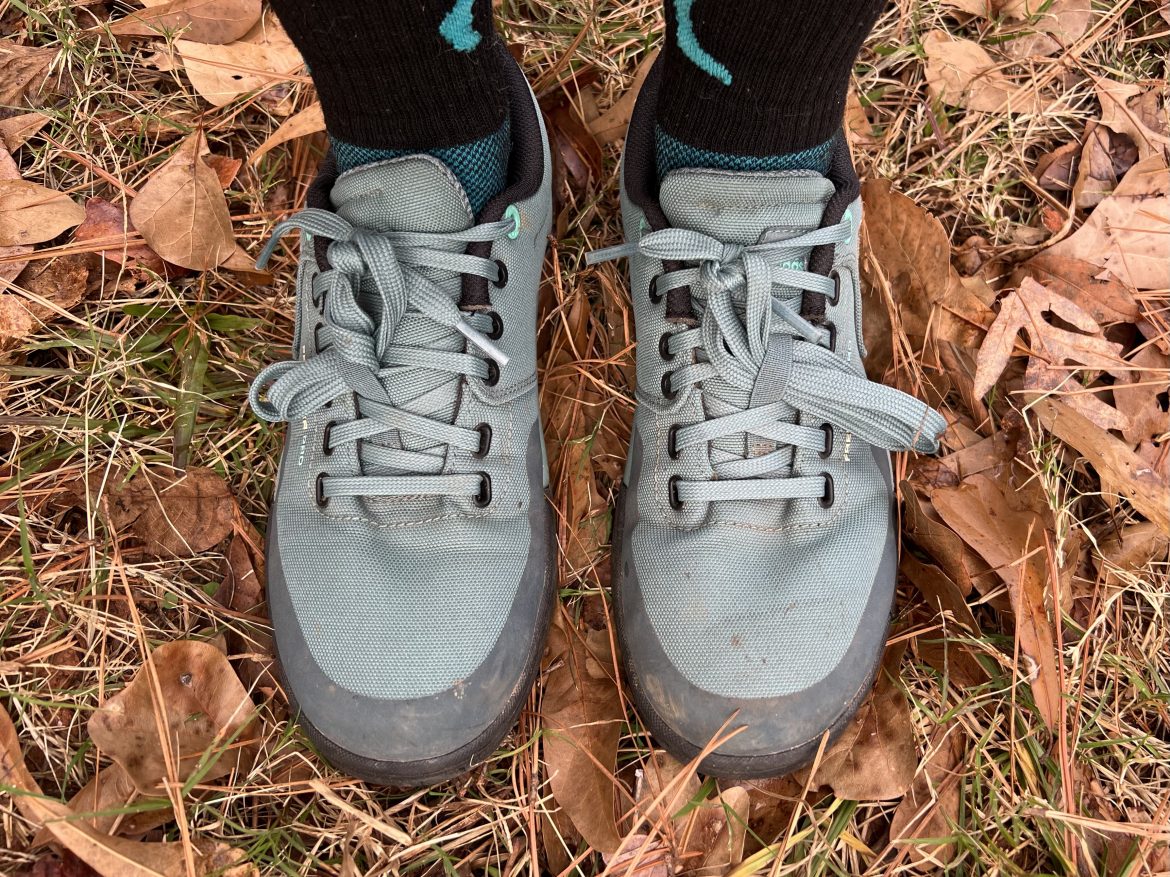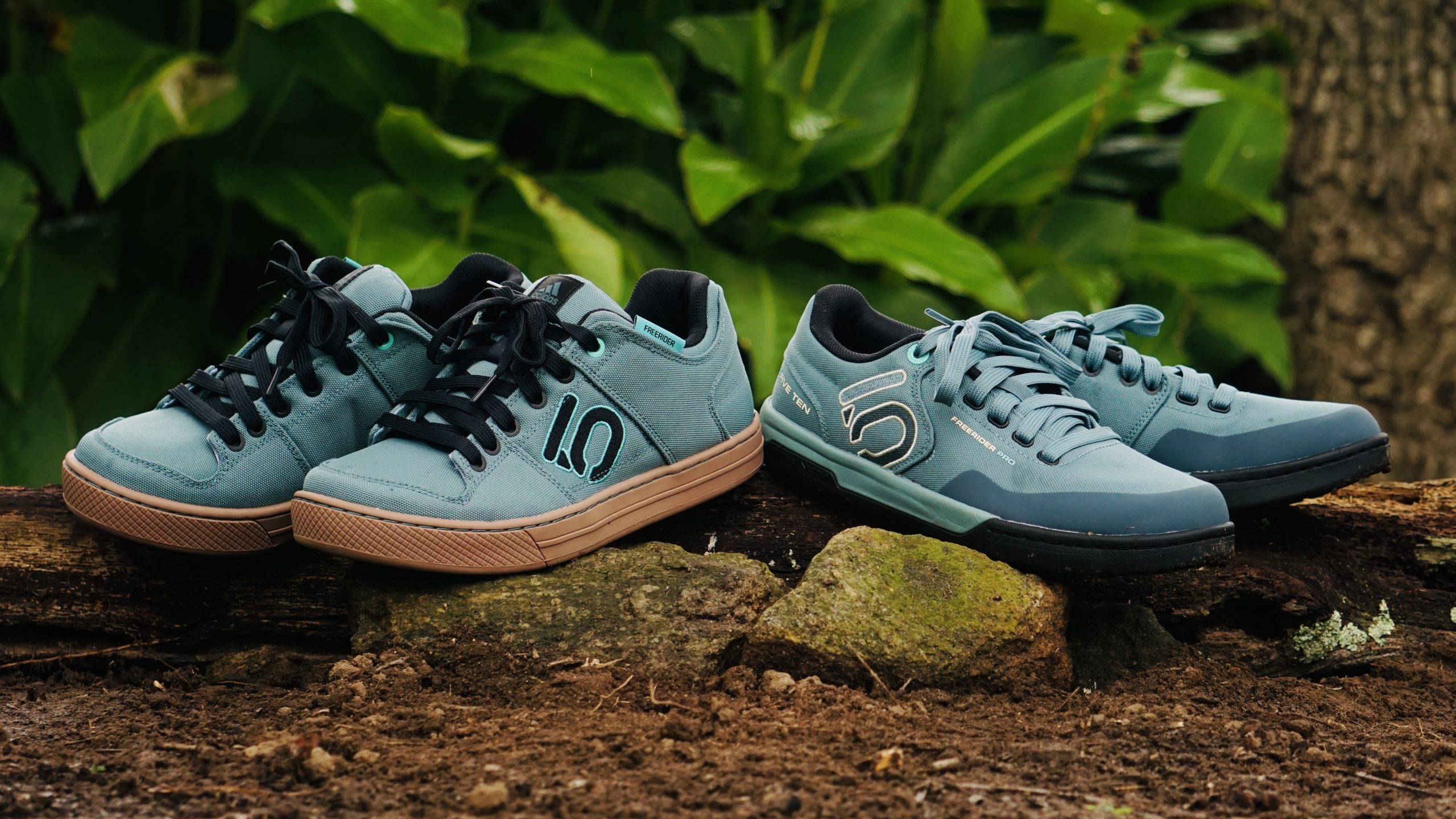Table of Contents
Five Ten has been the gold standard in mountain bike footwear seemingly since the dawn of time. The Freerider is easily one of the brand’s most popular shoes, and the Freerider lineup has grown over the years to include different materials, styles, and sizes to fit virtually all rider types and sizes.
Today the brand offers two main Freerider models: Freerider and Freerider Pro. The key differences between the two comes down to stiffness and the construction of the shoe. The Freerider Pro provides a more supportive pedaling platform with a sleeker, more form-fitting upper, while the Freerider is more geared toward comfort with a casual style. Both versions feature the signature Stealth S1 Dotty rubber sole offering plenty of traction. Read on to get more details for each shoe, and to find out how each pair performs.
Eco-friendly and Primeblue
With a legacy of making the grippiest shoes on the market, it’s hard to come up with new ways to innovate and improve on an already excellent product. In an effort to reduce their carbon footprint, Five Ten has given their highly revered Freerider and Freerider Pro flat pedal shoes an eco-friendly facelift, bringing the same excellent grip to riders with a more environmentally friendly approach, paving the way for a greener future.
We tested the Freerider and Freerider Pro featuring Primeblue, a textile created from recycled plastic, harvested from the ocean, and woven into a high-performance fabric. Five Ten also offers non-Primeblue versions of the Freerider and Freerider Pro shoes which also make use of some recycled materials.
Freerider Pro Primeblue
The Five Ten Freerider Pro is one of the most popular flat pedal shoes on the market for a reason. Featuring Five Ten’s famous Stealth rubber soles with their iconic Dotty tread pattern, these low-profile kicks will keep your feet stuck to your pedals with comfort and style.

The teal color of this women’s version brings a nice splash to what is generally a fairly drab category of footwear. The “Hazy Emerald” synthetic uppers are made of 75% Primeblue fabric. With no virgin polyester in the textiles, you can feel great about looking this good.
The shoe is slim-fitting with a low profile. I like how light these shoes feel, and the fact that they are comfortable enough to wear on and off the bike. A molded EVA midsole and ortholite sock liner provide plenty of comfort and support, while the triple-layered toe box saved my toes from numerous encounters of the rocky kind.
The Freerider Pros appear to have a lower stack height than their more skate-shoe-like Freerider cousin, with a fairly thin yet stiff sole. This helped me feel more planted on the pedals, riding the bike rather than floating on top of it. I also like that the toe box isn’t as aggressively curled up like the Freeriders, allowing my foot to settle more naturally.
My testing conditions were generally dry and mud-free, so I can’t speak to the water repellency of the Primeblue fabric. The literature on the Five Ten website describes them as “quick-drying,” so I would gauge these shoes as a warmer or dryer weather pair that isn’t afraid of the occasional creek crossing (though I wouldn’t plan on wading through any puddles).
For flat pedal shoes, the grippiness of the sole is the most crucial detail to consider. Five Ten is known for its Stealth Dotty rubber, featuring a slightly raised polka dot pattern on its soft rubber tread, a delicious treat for the traction pins to bite into.
⭐️ The Five Ten Freerider Pro Primeblue shoes are available at Competitive Cyclist and other online retailers.
This was my first excursion aboard a pair of Five Ten Freerider Pros, and I must admit I was skeptical about their sticky reputation. At first, the sole was stiff and not exactly accepting the sharp embrace of my flat pedals. It took a few rides, but the rubber eventually warmed up to the idea of being a pin cushion and broke in nicely. Once the break-in period was over I felt like I could trust the grip of the Freerider Pros to carry me through anything.
Even if you already own a pair of Five Tens, I strongly recommend you go try these shoes on before you buy. My normal size was too tight for comfort, so I went up a half size in anticipation of an expanding foot, but I never felt like I fully filled in the shoe. Initially, the fit was sloppy, but with some strategic tightening of laces, I managed to create a more precise fit, giving me better control while riding. Flat pedal shoe fit is critical to ride feel and performance. The snugger the fit, the less likely you are to slide inside your shoe before giving the pedal any input. I highly recommend trying on multiple sizes and weighing the pros and cons of a tighter vs. looser fit.

The toe box is spacious and leaves plenty of room to wiggle your digits. The downside to this is that the excess volume of material created a weird pinch-point that would attack the top of my foot every time I knelt down or had any serious bend in my toes. While not a deal-breaker in regards to performance on the bike, it’s definitely an annoyance that made me reconsider my movements off the bike, like crouching down to change a tire.
Long-term durability remains to be seen, but at this point, I’m very pleased with the construction and quality of the shoe. The Stealth rubber is proving to be resilient and is slowly starting to show its scars, while the Primeblue uppers are still looking fresh and vibrant.
If you’re looking for a fantastic flat pedal shoe with an environmentally friendly slant, consider the Five Ten Freerider Pro. The Stealth Dotty rubber has a short break-in period, and gaining access to that legendary sticky sole is worth the wait.
The Five Ten Freerider Pro Primeblue shoes are currently on sale for $90 at REI, down from $150. This version comes in Hazy Emerald, but new, non-Primeblue models are available in additional colors. The pair I tested weighs 646g.
Party laps
- Lighteright
- Low profile
- Good grip and stiffness once broken in
Pros and cons of the Freeride Pro shoes.
Dirt naps
- Extra long laces are difficult to wrangle
- Toe box creates a pinch point
- Not a lot of protection
Freerider
The Five Ten Freerider is an excellent entry-level mountain bike flat pedal shoe with a little extra give and plenty of style and comfort to slay some trail. Riding on the coattails of the Pro version, this budget-friendly shoe delivers excellent grip and performance without breaking the bank.

These shoes have been in Five Ten’s lineup for years, with the biggest change in coloring and now the choice of a more environmentally friendly textile. The Primeblue fabric brings a mix of Parley Ocean Plastic made from recycled bottles, with a nice teal color to remind us of our connection to nature and the world’s oceans.
The bottom of the Freerider features a one-piece molded cupsole, giving the shoe a simpler design and construction than its Pro cousin. This sole is thicker and chunkier, but that doesn’t necessarily equate to any added stiffness. I found these shoes to be softer and more flexible than the Pro version, adding greatly to the comfort factor, but detracting from their overall performance.
⭐️ The Five Ten Freerider Primeblue shoes are available at the Five Ten website, evo, or Competitive Cyclist.
The sole features Five Ten’s Stealth S1 rubber with the Dotty pattern, giving you a velcro-like connection between shoe and pedal — provided you take the time to break them in. Right out of the box, I found the rubber to be less than tacky, but it rapidly improved over the course of a few rides. The slightly upturned toe box is a bit strange at first, but gradually flattens out the more you wear them.
With a mid-range stiffness out of the box, the Freeriders felt great at first, but over time that rubber sole is going to break down and loosen up. If you prefer a stiffer sole, I would recommend the Freerider Pros.
I wouldn’t say these shoes offer much in the way of extra protection, but I did notice that the uppers were a bit thicker and padded in strategic places, like where your ankle makes contact with the crank arm. They did OK with ventilation and heat regulation, but they don’t strike me as being a particularly quick-drying shoe when things get soggy.
The fit of these shoes struck me as being more comfort-oriented than performance-driven. A spacious toe box leaves plenty of room to get settled in, and a well-cushioned upper comfortably wraps around your foot to keep things in place. The downside was that I really had to crank down on the shoelaces to feel any sort of control on my pedals. The looser the shoe, the sloppier they ride, so it was critical to making sure my foot wasn’t sliding around too much.
The bulk and the excessively long shoelaces take away from the aesthetics of the shoe, but overall these factors aren’t all that distracting while riding. Long lace management seems to be a hallmark of the Five Ten Freerider experience, so be prepared with a more reasonable length.
Overall, the Five Ten Freeriders are a great shoe to start your flat pedal journey, but If you’re looking for better performance and stiffness, give the Freerider Pros a try. My test pair weighs 769g.
Find yourself a pair of Freerider Primeblue shoes on sale for about $70 at the Five Ten website, evo, or Competitive Cyclist.
Party laps
- Comfortable enough to wear all day
- Strategic padding for protection
- Great price
Pros and cons of the Five Ten Freerider shoes.
Dirt naps
- Shoe feels bulky
- Soft sole isn’t very supportive
- Too spacious inside
https://www.singletracks.com/mtb-gear/five-ten-freerider-vs-freerider-pro-mtb-shoe-review/
 fashion rec fashion wanted
fashion rec fashion wanted





